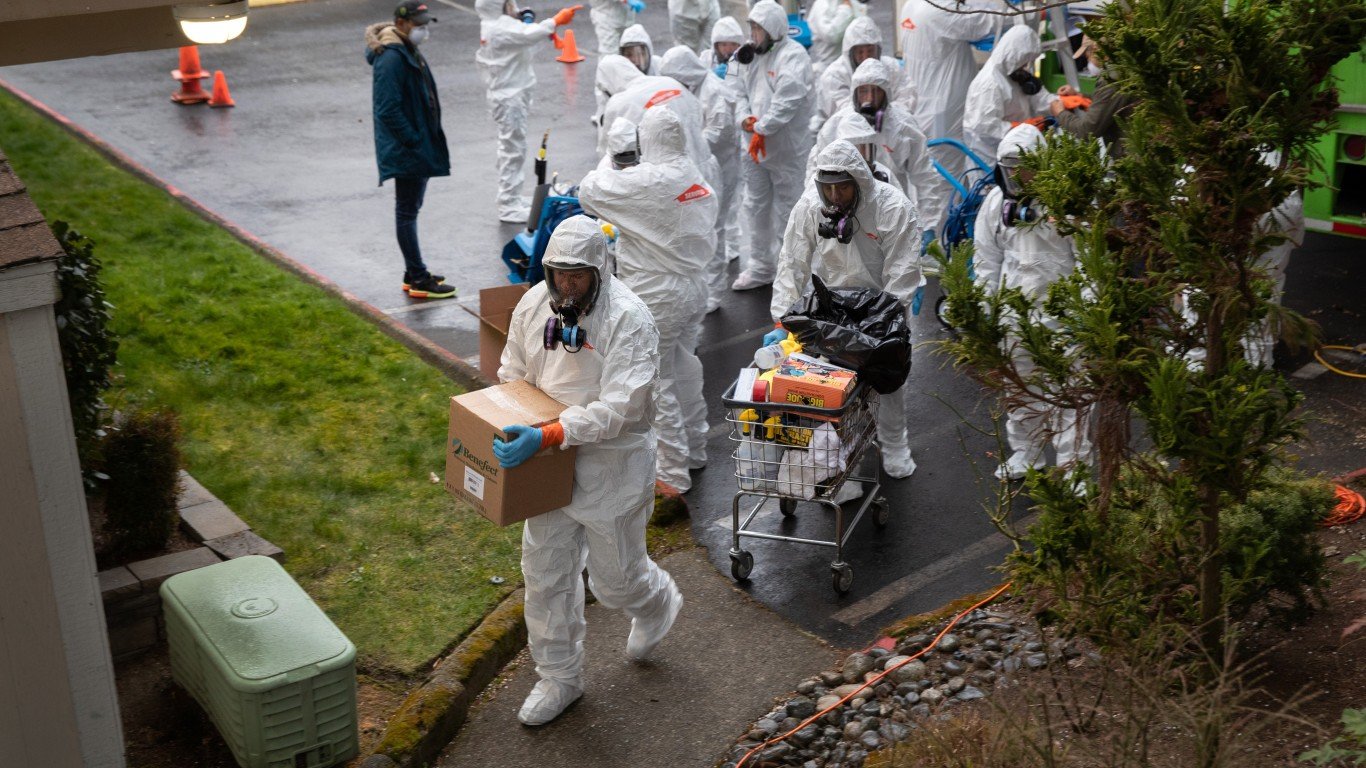

The U.S. has reported more than 23,000,000 confirmed COVID-19 cases as of Jan. 19. There have been more than 380,000 reported deaths from COVID-19-related causes — the highest death toll of any country.
The extent of the spread of the novel coronavirus continues to vary considerably from state to state, and from city to city. Even as the number of daily new cases is flattening or even declining in some parts of the country, it is surging in others.
Nationwide, the number of new cases is growing at a steady rate. There were an average of 67.2 daily new coronavirus cases per 100,000 Americans in the week ending Jan. 19, essentially unchanged from the week prior, when there were an average of 72.1 daily new coronavirus cases per 100,000 people.
Metropolitan areas with a high degree of mobility and a large population may be particularly vulnerable to outbreaks. While science and medical professionals are still studying how exactly the virus spreads, experts agree that outbreaks are more likely to occur in group settings where large numbers of people routinely have close contact with one another. Cities with high concentrations of dense spaces such as colleges, correctional facilities, and nursing homes are particularly at risk.
The city with the highest seven-day average of new daily COVID-19 cases per capita is in Texas. In the Laredo, TX, metro area, there were an average of 245.4 daily new coronavirus cases per 100,000 residents in the week ending Jan. 19, the most of any U.S. metro area. Other cities where COVID-19 is growing the fastest include Fort Smith, AR-OK; Fayetteville-Springdale-Rogers, AR; and Oxnard-Thousand Oaks-Ventura, CA.
To determine the metropolitan area in each state where COVID-19 is growing the fastest, 24/7 Wall St. compiled and reviewed data from state and local health departments. We ranked metropolitan areas according to the average number of new daily COVID-19 cases per 100,000 residents in the seven days ending Jan. 19. Data was aggregated from the county level to the metropolitan area level using boundary definitions from the U.S. Census Bureau. Population data used to adjust case and death totals came from the U.S. Census Bureau’s 2018 American Community Survey and are five-year estimates. Unemployment data is from the Bureau of Labor Statistics and is seasonally adjusted.

Alabama: Gadsden
Avg. new daily cases in Gadsden in week ending Jan. 19: 92.5 per 100,000
Avg. new daily cases in Gadsden in week ending Jan. 12: 104.4 per 100,000
COVID-19 cases in Gadsden as of Jan. 19: 11,805 (11,468.0 per 100,000)
Peak pandemic unemployment in Gadsden: 19.2% (April 2020)
Gadsden population: 102,939 (192.4 people per sq. mi.)

Alaska: Anchorage
Avg. new daily cases in Anchorage in week ending Jan. 19: 0.9 per 100,000
Avg. new daily cases in Anchorage in week ending Jan. 12: 0.3 per 100,000
COVID-19 cases in Anchorage as of Jan. 19: 20,172 (5,048.4 per 100,000)
Peak pandemic unemployment in Anchorage: 14.8% (April 2020)
Anchorage population: 399,576 (15.2 people per sq. mi.)
These are all the counties in Alaska where COVID-19 is slowing (and where it’s still getting worse).
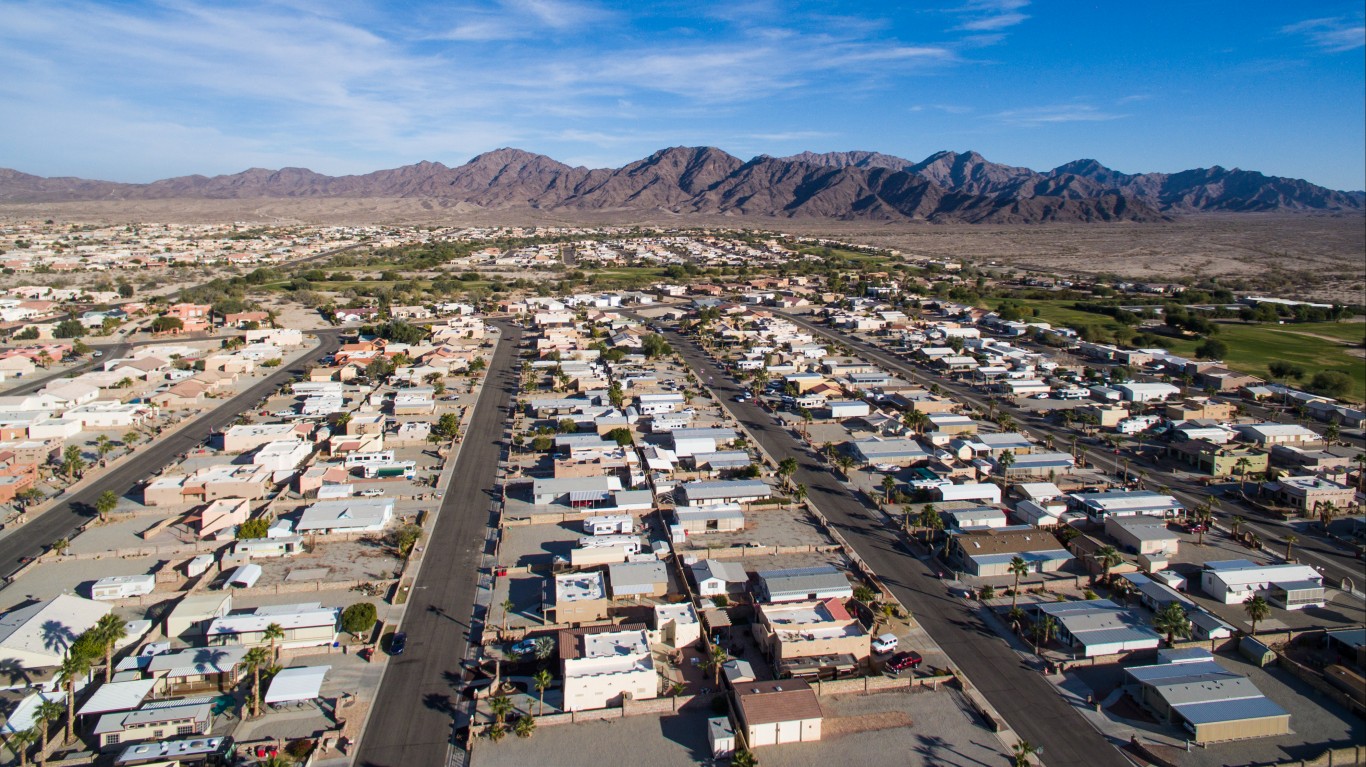
Arizona: Yuma
Avg. new daily cases in Yuma in week ending Jan. 19: 133.8 per 100,000
Avg. new daily cases in Yuma in week ending Jan. 12: 165.8 per 100,000
COVID-19 cases in Yuma as of Jan. 19: 33,447 (16,093.5 per 100,000)
Peak pandemic unemployment in Yuma: 25.0% (April 2020)
Yuma population: 207,829 (37.7 people per sq. mi.)

Arkansas: Fort Smith, AR-OK
Avg. new daily cases in Fort Smith in week ending Jan. 19: 159.9 per 100,000
Avg. new daily cases in Fort Smith in week ending Jan. 12: 154.4 per 100,000
COVID-19 cases in Fort Smith as of Jan. 19: 26,526 (10,649.9 per 100,000)
Peak pandemic unemployment in Fort Smith: 12.4% (April 2020)
Fort Smith population: 249,072 (103.5 people per sq. mi.)

California: Oxnard-Thousand Oaks-Ventura
Avg. new daily cases in Oxnard in week ending Jan. 19: 143.1 per 100,000
Avg. new daily cases in Oxnard in week ending Jan. 12: 144 per 100,000
COVID-19 cases in Oxnard as of Jan. 19: 61,859 (7,293.7 per 100,000)
Peak pandemic unemployment in Oxnard: 14.4% (April 2020)
Oxnard population: 848,112 (460.1 people per sq. mi.)

Colorado: Grand Junction
Avg. new daily cases in Grand Junction in week ending Jan. 19: 71.4 per 100,000
Avg. new daily cases in Grand Junction in week ending Jan. 12: 68.2 per 100,000
COVID-19 cases in Grand Junction as of Jan. 19: 10,880 (7,253.4 per 100,000)
Peak pandemic unemployment in Grand Junction: 12.5% (April 2020)
Grand Junction population: 149,998 (45.1 people per sq. mi.)

Connecticut: Norwich-New London
Avg. new daily cases in Norwich in week ending Jan. 19: 93.9 per 100,000
Avg. new daily cases in Norwich in week ending Jan. 12: 85.4 per 100,000
COVID-19 cases in Norwich as of Jan. 19: 15,086 (5,610.7 per 100,000)
Peak pandemic unemployment in Norwich: 15.0% (May 2020)
Norwich population: 268,881 (404.4 people per sq. mi.)

Delaware: Dover
Avg. new daily cases in Dover in week ending Jan. 19: 71.4 per 100,000
Avg. new daily cases in Dover in week ending Jan. 12: 71.9 per 100,000
COVID-19 cases in Dover as of Jan. 19: 11,548 (6,605.6 per 100,000)
Peak pandemic unemployment in Dover: 17.3% (May 2020)
Dover population: 174,822 (298.2 people per sq. mi.)

Florida: Pensacola-Ferry Pass-Brent
Avg. new daily cases in Pensacola in week ending Jan. 19: 90.1 per 100,000
Avg. new daily cases in Pensacola in week ending Jan. 12: 101 per 100,000
COVID-19 cases in Pensacola as of Jan. 19: 41,691 (8,650.2 per 100,000)
Peak pandemic unemployment in Pensacola: 12.2% (April 2020)
Pensacola population: 481,964 (288.9 people per sq. mi.)

Georgia: Dalton
Avg. new daily cases in Dalton in week ending Jan. 19: 102.3 per 100,000
Avg. new daily cases in Dalton in week ending Jan. 12: 89.5 per 100,000
COVID-19 cases in Dalton as of Jan. 19: 15,958 (11,127.8 per 100,000)
Peak pandemic unemployment in Dalton: 20.3% (April 2020)
Dalton population: 143,406 (225.9 people per sq. mi.)

Hawaii: Kahului-Wailuku-Lahaina
Avg. new daily cases in Kahului in week ending Jan. 19: 16.2 per 100,000
Avg. new daily cases in Kahului in week ending Jan. 12: 19.1 per 100,000
COVID-19 cases in Kahului as of Jan. 19: 1,618 (978.9 per 100,000)
Peak pandemic unemployment in Kahului: 34.8% (April 2020)
Kahului population: 165,281 (142.3 people per sq. mi.)
These are all the counties in Hawaii where COVID-19 is slowing (and where it’s still getting worse).

Idaho: Coeur d’Alene
Avg. new daily cases in Coeur d’Alene in week ending Jan. 19: 81.1 per 100,000
Avg. new daily cases in Coeur d’Alene in week ending Jan. 12: 94.6 per 100,000
COVID-19 cases in Coeur d’Alene as of Jan. 19: 14,891 (9,694.3 per 100,000)
Peak pandemic unemployment in Coeur d’Alene: 17.2% (April 2020)
Coeur d’Alene population: 153,605 (123.5 people per sq. mi.)
These are all the counties in Idaho where COVID-19 is slowing (and where it’s still getting worse).
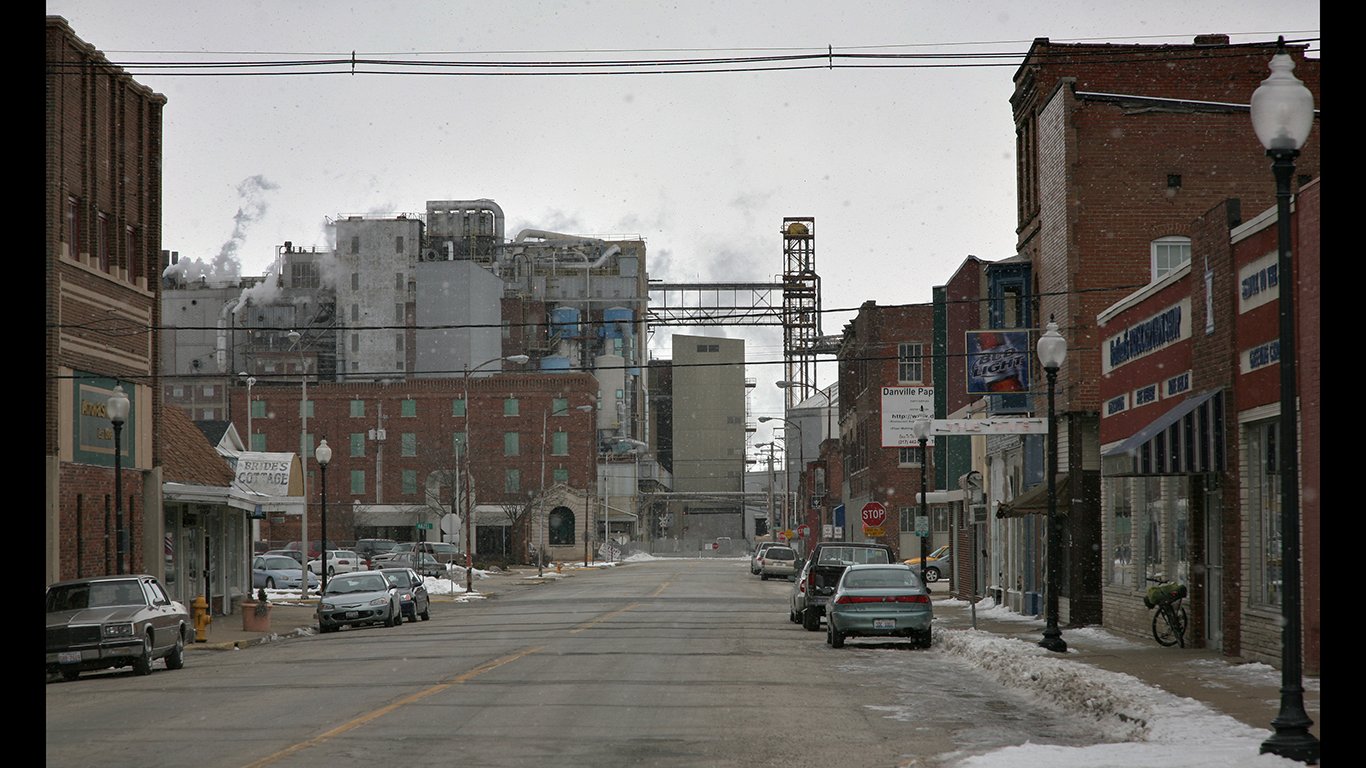
Illinois: Danville
Avg. new daily cases in Danville in week ending Jan. 19: 74.2 per 100,000
Avg. new daily cases in Danville in week ending Jan. 12: 81.4 per 100,000
COVID-19 cases in Danville as of Jan. 19: 7,538 (9,613.9 per 100,000)
Peak pandemic unemployment in Danville: 18.4% (April 2020)
Danville population: 78,407 (87.3 people per sq. mi.)

Indiana: Evansville, IN-KY
Avg. new daily cases in Evansville in week ending Jan. 19: 93.5 per 100,000
Avg. new daily cases in Evansville in week ending Jan. 12: 112 per 100,000
COVID-19 cases in Evansville as of Jan. 19: 31,384 (9,964.2 per 100,000)
Peak pandemic unemployment in Evansville: 15.2% (April 2020)
Evansville population: 314,967 (215.1 people per sq. mi.)

Iowa: Des Moines-West Des Moines
Avg. new daily cases in Des Moines in week ending Jan. 19: 54.2 per 100,000
Avg. new daily cases in Des Moines in week ending Jan. 12: 58.7 per 100,000
COVID-19 cases in Des Moines as of Jan. 19: 64,315 (9,583.6 per 100,000)
Peak pandemic unemployment in Des Moines: 12.0% (April 2020)
Des Moines population: 671,092 (185.7 people per sq. mi.)
These are all the counties in Iowa where COVID-19 is slowing (and where it’s still getting worse).

Kansas: Manhattan
Avg. new daily cases in Manhattan in week ending Jan. 19: 81.1 per 100,000
Avg. new daily cases in Manhattan in week ending Jan. 12: 56.3 per 100,000
COVID-19 cases in Manhattan as of Jan. 19: 7,311 (5,466.7 per 100,000)
Peak pandemic unemployment in Manhattan: 9.0% (April 2020)
Manhattan population: 133,736 (72.9 people per sq. mi.)
These are all the counties in Kansas where COVID-19 is slowing (and where it’s still getting worse).

Kentucky: Owensboro
Avg. new daily cases in Owensboro in week ending Jan. 19: 95.9 per 100,000
Avg. new daily cases in Owensboro in week ending Jan. 12: 104.5 per 100,000
COVID-19 cases in Owensboro as of Jan. 19: 8,824 (7,478.8 per 100,000)
Peak pandemic unemployment in Owensboro: 15.5% (April 2020)
Owensboro population: 117,987 (131.3 people per sq. mi.)

Louisiana: New Orleans-Metairie
Avg. new daily cases in New Orleans in week ending Jan. 19: 76.2 per 100,000
Avg. new daily cases in New Orleans in week ending Jan. 12: 80.4 per 100,000
COVID-19 cases in New Orleans as of Jan. 19: 96,307 (7,621.4 per 100,000)
Peak pandemic unemployment in New Orleans: 20.0% (April 2020)
New Orleans population: 1,263,635 (394.7 people per sq. mi.)

Maine: Portland-South Portland
Avg. new daily cases in Portland in week ending Jan. 19: 64.8 per 100,000
Avg. new daily cases in Portland in week ending Jan. 12: 49.5 per 100,000
COVID-19 cases in Portland as of Jan. 19: 17,979 (3,396.6 per 100,000)
Peak pandemic unemployment in Portland: 10.9% (April 2020)
Portland population: 529,323 (254.5 people per sq. mi.)
These are all the counties in Maine where COVID-19 is slowing (and where it’s still getting worse).

Maryland: Hagerstown-Martinsburg, MD-WV
Avg. new daily cases in Hagerstown in week ending Jan. 19: 78.8 per 100,000
Avg. new daily cases in Hagerstown in week ending Jan. 12: 96.4 per 100,000
COVID-19 cases in Hagerstown as of Jan. 19: 19,600 (6,976.8 per 100,000)
Peak pandemic unemployment in Hagerstown: 12.0% (April 2020)
Hagerstown population: 280,930 (278.7 people per sq. mi.)

Massachusetts: Worcester, MA-CT
Avg. new daily cases in Worcester in week ending Jan. 19: 78.6 per 100,000
Avg. new daily cases in Worcester in week ending Jan. 12: 89.4 per 100,000
COVID-19 cases in Worcester as of Jan. 19: 61,494 (6,550.2 per 100,000)
Peak pandemic unemployment in Worcester: 15.9% (June 2020)
Worcester population: 938,818 (463.9 people per sq. mi.)

Michigan: Niles
Avg. new daily cases in Niles in week ending Jan. 19: 34.6 per 100,000
Avg. new daily cases in Niles in week ending Jan. 12: 41.7 per 100,000
COVID-19 cases in Niles as of Jan. 19: 10,322 (6,667.7 per 100,000)
Peak pandemic unemployment in Niles: 21.3% (April 2020)
Niles population: 154,807 (272.7 people per sq. mi.)

Minnesota: Rochester
Avg. new daily cases in Rochester in week ending Jan. 19: 39 per 100,000
Avg. new daily cases in Rochester in week ending Jan. 12: 49.7 per 100,000
COVID-19 cases in Rochester as of Jan. 19: 14,774 (6,838.7 per 100,000)
Peak pandemic unemployment in Rochester: 9.7% (May 2020)
Rochester population: 216,035 (87.2 people per sq. mi.)

Mississippi: Gulfport-Biloxi
Avg. new daily cases in Gulfport in week ending Jan. 19: 78.6 per 100,000
Avg. new daily cases in Gulfport in week ending Jan. 12: 69.3 per 100,000
COVID-19 cases in Gulfport as of Jan. 19: 28,211 (6,886.3 per 100,000)
Peak pandemic unemployment in Gulfport: 22.3% (April 2020)
Gulfport population: 409,668 (184.9 people per sq. mi.)

Missouri: St. Louis, MO-IL
Avg. new daily cases in St. Louis in week ending Jan. 19: 45.3 per 100,000
Avg. new daily cases in St. Louis in week ending Jan. 12: 54.9 per 100,000
COVID-19 cases in St. Louis as of Jan. 19: 210,104 (7,488.9 per 100,000)
Peak pandemic unemployment in St. Louis: 11.6% (April 2020)
St. Louis population: 2,805,551 (356.8 people per sq. mi.)

Montana: Missoula
Avg. new daily cases in Missoula in week ending Jan. 19: 43.6 per 100,000
Avg. new daily cases in Missoula in week ending Jan. 12: 45.1 per 100,000
COVID-19 cases in Missoula as of Jan. 19: 7,273 (6,270.7 per 100,000)
Peak pandemic unemployment in Missoula: 13.3% (April 2020)
Missoula population: 115,983 (44.7 people per sq. mi.)

Nebraska: Grand Island
Avg. new daily cases in Grand Island in week ending Jan. 19: 58.7 per 100,000
Avg. new daily cases in Grand Island in week ending Jan. 12: 54.7 per 100,000
COVID-19 cases in Grand Island as of Jan. 19: 7,541 (9,981.3 per 100,000)
Peak pandemic unemployment in Grand Island: 11.4% (April 2020)
Grand Island population: 75,551 (47.2 people per sq. mi.)

Nevada: Las Vegas-Henderson-Paradise
Avg. new daily cases in Las Vegas in week ending Jan. 19: 88.2 per 100,000
Avg. new daily cases in Las Vegas in week ending Jan. 12: 84.5 per 100,000
COVID-19 cases in Las Vegas as of Jan. 19: 202,471 (9,454.3 per 100,000)
Peak pandemic unemployment in Las Vegas: 34.2% (April 2020)
Las Vegas population: 2,141,574 (271.4 people per sq. mi.)
These are all the counties in Nevada where COVID-19 is slowing (and where it’s still getting worse).

New Hampshire: Manchester-Nashua
Avg. new daily cases in Manchester in week ending Jan. 19: 68.3 per 100,000
Avg. new daily cases in Manchester in week ending Jan. 12: 69.1 per 100,000
COVID-19 cases in Manchester as of Jan. 19: 23,111 (5,621.9 per 100,000)
Peak pandemic unemployment in Manchester: 17.5% (April 2020)
Manchester population: 411,087 (469.2 people per sq. mi.)

New Jersey: Atlantic City-Hammonton
Avg. new daily cases in Atlantic City in week ending Jan. 19: 86.5 per 100,000
Avg. new daily cases in Atlantic City in week ending Jan. 12: 87.9 per 100,000
COVID-19 cases in Atlantic City as of Jan. 19: 19,310 (7,190.8 per 100,000)
Peak pandemic unemployment in Atlantic City: 35.2% (June 2020)
Atlantic City population: 268,539 (483.2 people per sq. mi.)

New Mexico: Farmington
Avg. new daily cases in Farmington in week ending Jan. 19: 77.9 per 100,000
Avg. new daily cases in Farmington in week ending Jan. 12: 106 per 100,000
COVID-19 cases in Farmington as of Jan. 19: 12,243 (9,605.7 per 100,000)
Peak pandemic unemployment in Farmington: 14.5% (July 2020)
Farmington population: 127,455 (23.1 people per sq. mi.)

New York: Utica-Rome
Avg. new daily cases in Utica in week ending Jan. 19: 105.4 per 100,000
Avg. new daily cases in Utica in week ending Jan. 12: 124.1 per 100,000
COVID-19 cases in Utica as of Jan. 19: 20,414 (6,960.4 per 100,000)
Peak pandemic unemployment in Utica: 15.3% (April 2020)
Utica population: 293,287 (111.8 people per sq. mi.)

North Carolina: Hickory-Lenoir-Morganton
Avg. new daily cases in Hickory in week ending Jan. 19: 95.9 per 100,000
Avg. new daily cases in Hickory in week ending Jan. 12: 95.7 per 100,000
COVID-19 cases in Hickory as of Jan. 19: 32,251 (8,827.7 per 100,000)
Peak pandemic unemployment in Hickory: 18.2% (April 2020)
Hickory population: 365,339 (223.1 people per sq. mi.)
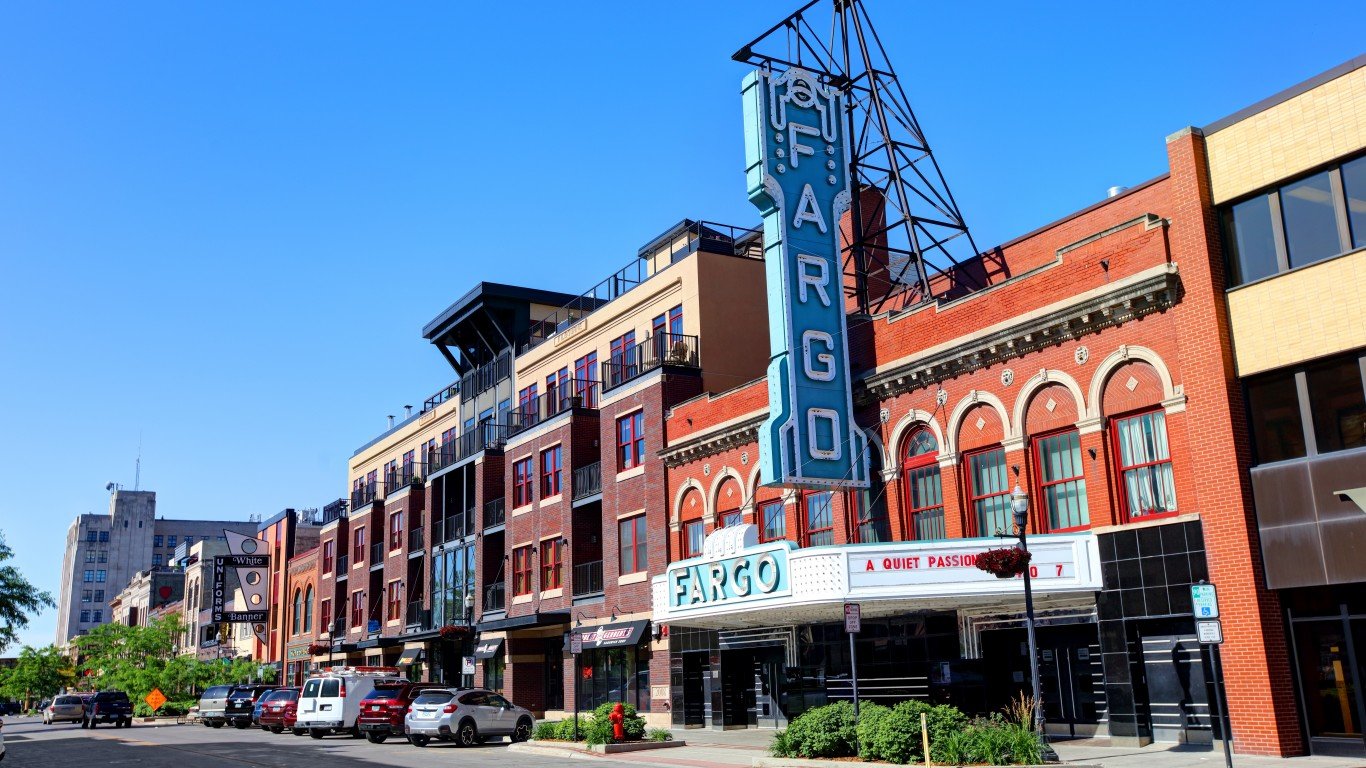
North Dakota: Fargo, ND-MN
Avg. new daily cases in Fargo in week ending Jan. 19: 23.2 per 100,000
Avg. new daily cases in Fargo in week ending Jan. 12: 31.6 per 100,000
COVID-19 cases in Fargo as of Jan. 19: 27,212 (11,481.7 per 100,000)
Peak pandemic unemployment in Fargo: 7.7% (April 2020)
Fargo population: 237,003 (84.3 people per sq. mi.)

Ohio: Cincinnati, OH-KY-IN
Avg. new daily cases in Cincinnati in week ending Jan. 19: 74.6 per 100,000
Avg. new daily cases in Cincinnati in week ending Jan. 12: 78.5 per 100,000
COVID-19 cases in Cincinnati as of Jan. 19: 166,917 (7,616.0 per 100,000)
Peak pandemic unemployment in Cincinnati: 14.5% (April 2020)
Cincinnati population: 2,191,667 (481.4 people per sq. mi.)
These are all the counties in Ohio where COVID-19 is slowing (and where it’s still getting worse).
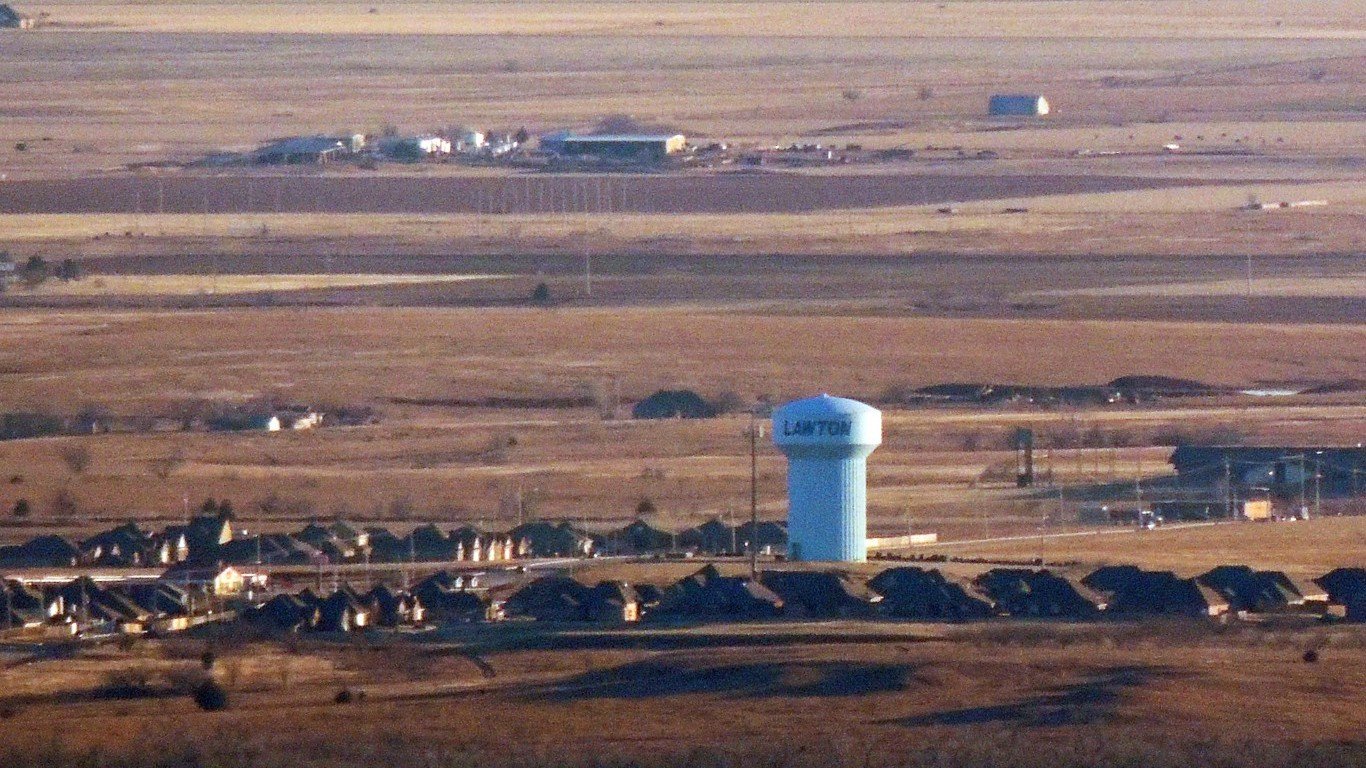
Oklahoma: Lawton
Avg. new daily cases in Lawton in week ending Jan. 19: 100 per 100,000
Avg. new daily cases in Lawton in week ending Jan. 12: 78.7 per 100,000
COVID-19 cases in Lawton as of Jan. 19: 9,396 (7,312.6 per 100,000)
Peak pandemic unemployment in Lawton: 19.5% (April 2020)
Lawton population: 128,490 (75.5 people per sq. mi.)

Oregon: Grants Pass
Avg. new daily cases in Grants Pass in week ending Jan. 19: 42.5 per 100,000
Avg. new daily cases in Grants Pass in week ending Jan. 12: 33.2 per 100,000
COVID-19 cases in Grants Pass as of Jan. 19: 1,770 (2,070.6 per 100,000)
Peak pandemic unemployment in Grants Pass: 15.1% (April 2020)
Grants Pass population: 85,481 (52.1 people per sq. mi.)
These are all the counties in Oregon where COVID-19 is slowing (and where it’s still getting worse).
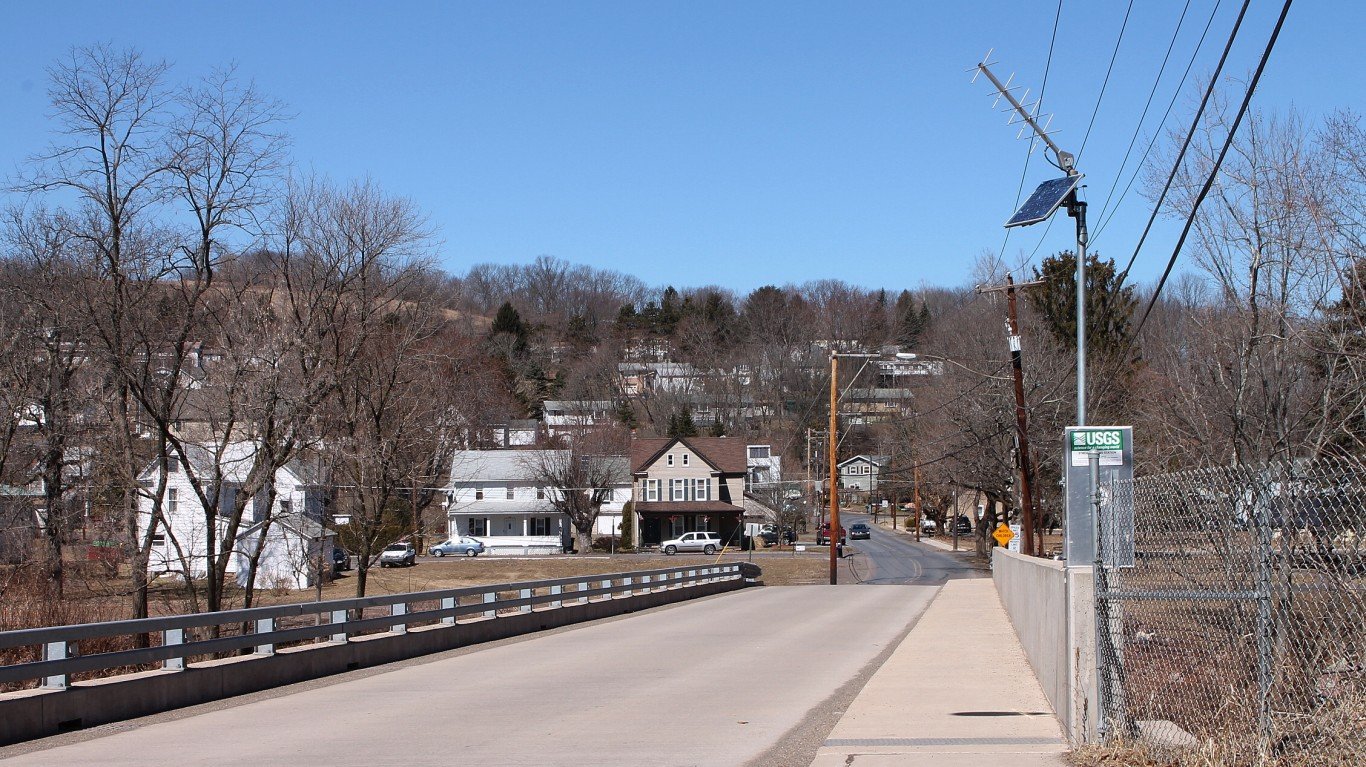
Pennsylvania: Bloomsburg-Berwick
Avg. new daily cases in Bloomsburg in week ending Jan. 19: 89.3 per 100,000
Avg. new daily cases in Bloomsburg in week ending Jan. 12: 93 per 100,000
COVID-19 cases in Bloomsburg as of Jan. 19: 5,232 (6,190.7 per 100,000)
Peak pandemic unemployment in Bloomsburg: 14.8% (April 2020)
Bloomsburg population: 84,514 (137.8 people per sq. mi.)

Rhode Island: Providence-Warwick, RI-MA
Avg. new daily cases in Providence in week ending Jan. 19: 100.8 per 100,000
Avg. new daily cases in Providence in week ending Jan. 12: 94 per 100,000
COVID-19 cases in Providence as of Jan. 19: 137,117 (8,487.5 per 100,000)
Peak pandemic unemployment in Providence: 18.5% (April 2020)
Providence population: 1,615,516 (1018 people per sq. mi.)
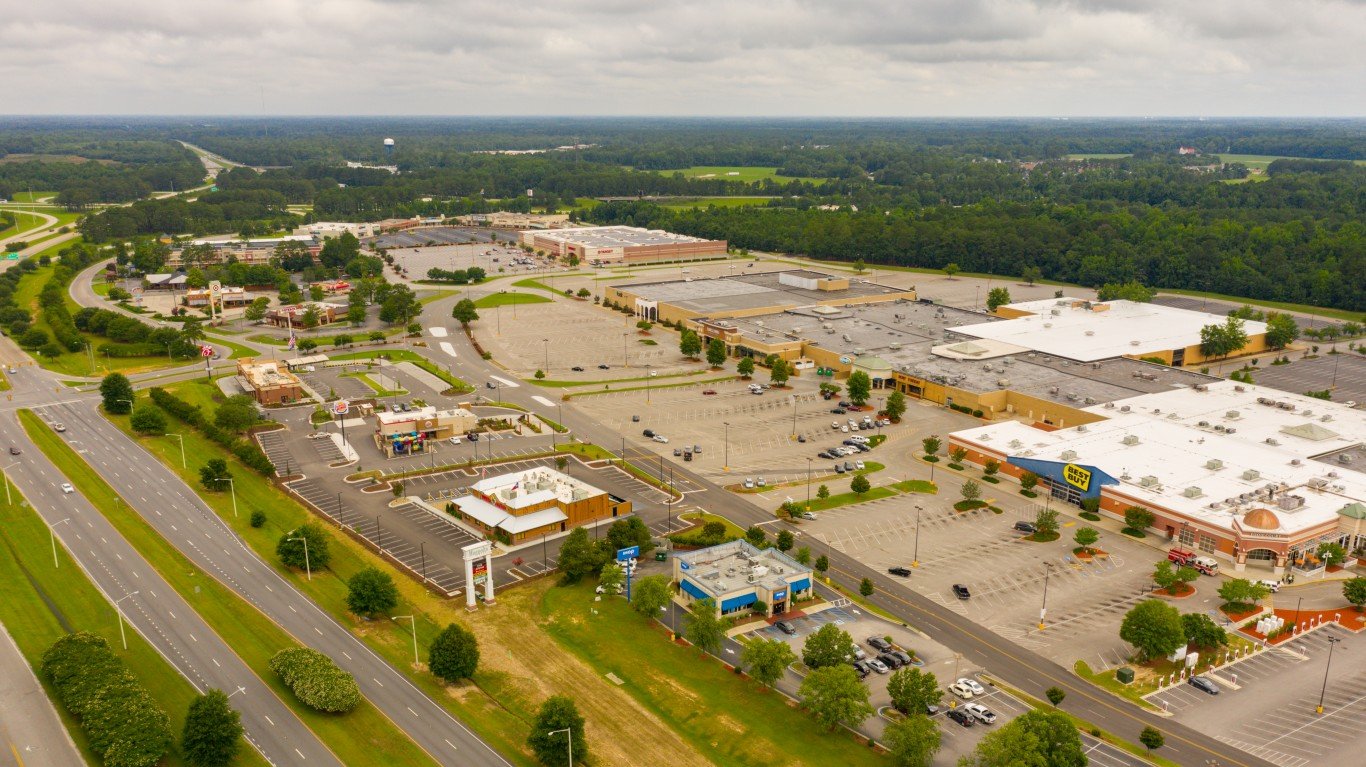
South Carolina: Florence
Avg. new daily cases in Florence in week ending Jan. 19: 128 per 100,000
Avg. new daily cases in Florence in week ending Jan. 12: 131.3 per 100,000
COVID-19 cases in Florence as of Jan. 19: 20,061 (9,747.2 per 100,000)
Peak pandemic unemployment in Florence: 9.4% (May 2020)
Florence population: 205,814 (151.2 people per sq. mi.)

South Dakota: Sioux Falls
Avg. new daily cases in Sioux Falls in week ending Jan. 19: 38 per 100,000
Avg. new daily cases in Sioux Falls in week ending Jan. 12: 51.5 per 100,000
COVID-19 cases in Sioux Falls as of Jan. 19: 35,438 (13,873.4 per 100,000)
Peak pandemic unemployment in Sioux Falls: 10.7% (April 2020)
Sioux Falls population: 255,438 (99.2 people per sq. mi.)
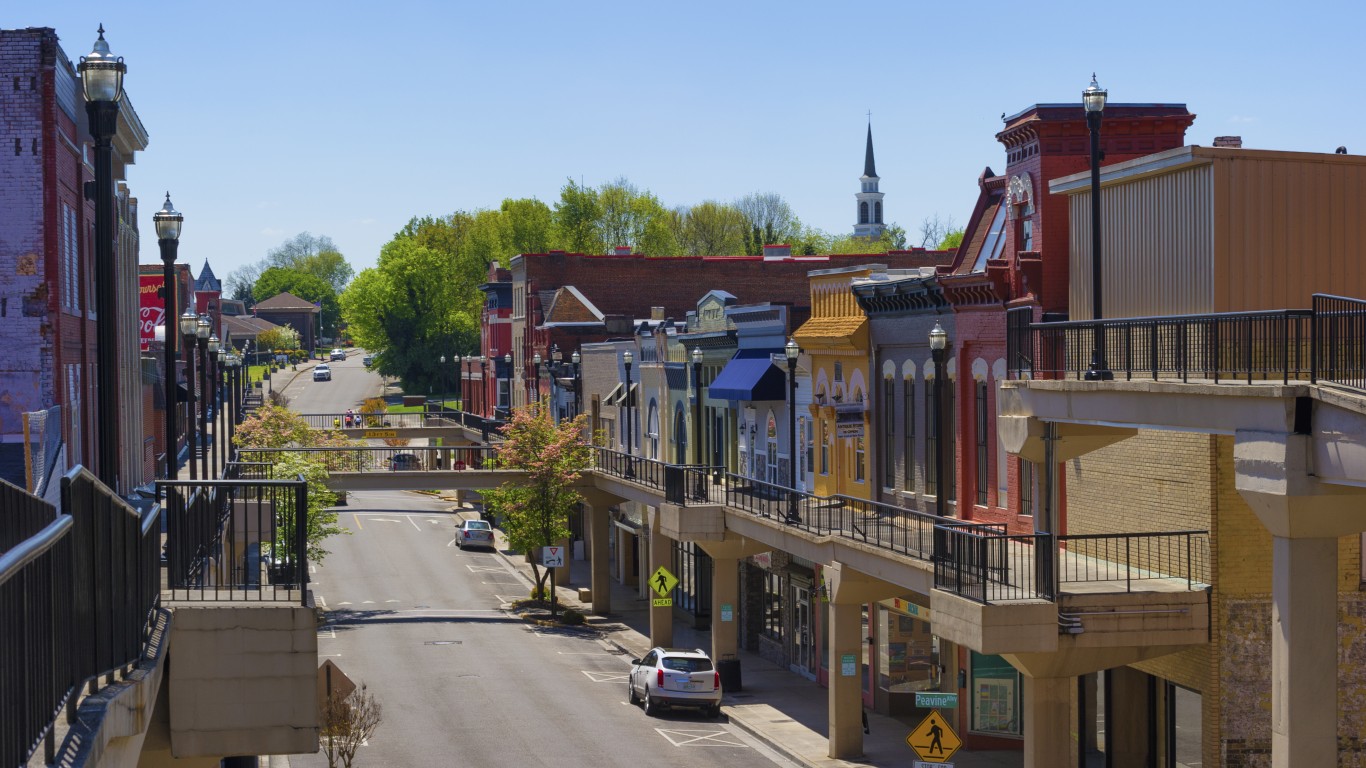
Tennessee: Morristown
Avg. new daily cases in Morristown in week ending Jan. 19: 91.4 per 100,000
Avg. new daily cases in Morristown in week ending Jan. 12: 96.4 per 100,000
COVID-19 cases in Morristown as of Jan. 19: 13,922 (9,944.3 per 100,000)
Peak pandemic unemployment in Morristown: 16.4% (April 2020)
Morristown population: 140,000 (195.6 people per sq. mi.)

Texas: Laredo
Avg. new daily cases in Laredo in week ending Jan. 19: 245.4 per 100,000
Avg. new daily cases in Laredo in week ending Jan. 12: 78.7 per 100,000
COVID-19 cases in Laredo as of Jan. 19: 34,690 (12,751.2 per 100,000)
Peak pandemic unemployment in Laredo: 14.3% (May 2020)
Laredo population: 272,053 (80.9 people per sq. mi.)
These are all the counties in Texas where COVID-19 is slowing (and where it’s still getting worse).

Utah: Provo-Orem
Avg. new daily cases in Provo in week ending Jan. 19: 122.8 per 100,000
Avg. new daily cases in Provo in week ending Jan. 12: 126.3 per 100,000
COVID-19 cases in Provo as of Jan. 19: 79,680 (13,495.0 per 100,000)
Peak pandemic unemployment in Provo: 8.1% (April 2020)
Provo population: 590,440 (294.7 people per sq. mi.)
These are all the counties in Utah where COVID-19 is slowing (and where it’s still getting worse).

Vermont: Burlington-South Burlington
Avg. new daily cases in Burlington in week ending Jan. 19: 28.3 per 100,000
Avg. new daily cases in Burlington in week ending Jan. 12: 28.1 per 100,000
COVID-19 cases in Burlington as of Jan. 19: 4,387 (2,012.0 per 100,000)
Peak pandemic unemployment in Burlington: 14.8% (April 2020)
Burlington population: 218,042 (174.1 people per sq. mi.)

Virginia: Lynchburg
Avg. new daily cases in Lynchburg in week ending Jan. 19: 109.7 per 100,000
Avg. new daily cases in Lynchburg in week ending Jan. 12: 84.8 per 100,000
COVID-19 cases in Lynchburg as of Jan. 19: 16,281 (6,245.9 per 100,000)
Peak pandemic unemployment in Lynchburg: 10.6% (April 2020)
Lynchburg population: 260,668 (123.3 people per sq. mi.)

Washington: Yakima
Avg. new daily cases in Yakima in week ending Jan. 19: 69 per 100,000
Avg. new daily cases in Yakima in week ending Jan. 12: 84.7 per 100,000
COVID-19 cases in Yakima as of Jan. 19: 22,988 (9,220.1 per 100,000)
Peak pandemic unemployment in Yakima: 14.6% (April 2020)
Yakima population: 249,325 (58 people per sq. mi.)

West Virginia: Wheeling, WV-OH
Avg. new daily cases in Wheeling in week ending Jan. 19: 70.7 per 100,000
Avg. new daily cases in Wheeling in week ending Jan. 12: 76.2 per 100,000
COVID-19 cases in Wheeling as of Jan. 19: 9,750 (6,834.2 per 100,000)
Peak pandemic unemployment in Wheeling: 17.7% (April 2020)
Wheeling population: 142,664 (151.2 people per sq. mi.)
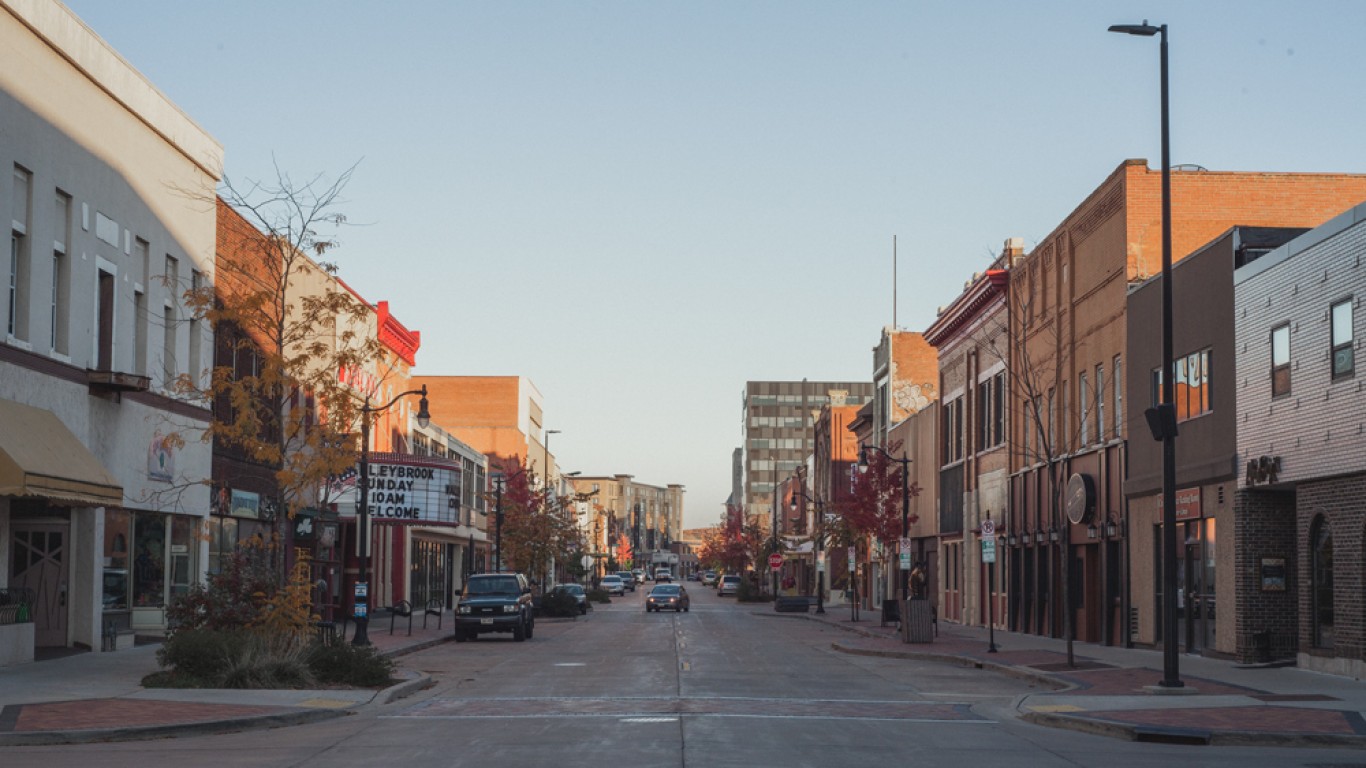
Wisconsin: Eau Claire
Avg. new daily cases in Eau Claire in week ending Jan. 19: 50.9 per 100,000
Avg. new daily cases in Eau Claire in week ending Jan. 12: 56.6 per 100,000
COVID-19 cases in Eau Claire as of Jan. 19: 16,676 (10,008.0 per 100,000)
Peak pandemic unemployment in Eau Claire: 12.4% (April 2020)
Eau Claire population: 166,626 (101.2 people per sq. mi.)
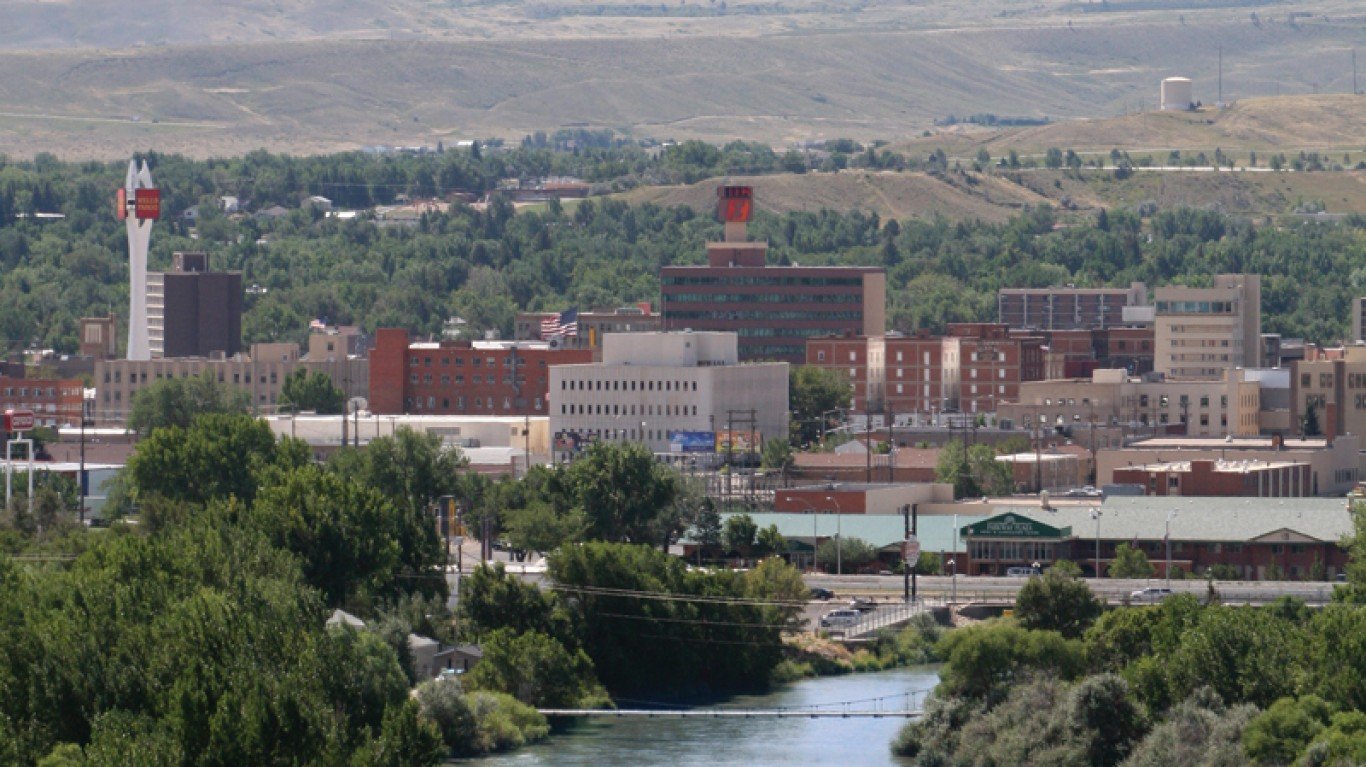
Wyoming: Casper
Avg. new daily cases in Casper in week ending Jan. 19: 56.4 per 100,000
Avg. new daily cases in Casper in week ending Jan. 12: 44.4 per 100,000
COVID-19 cases in Casper as of Jan. 19: 7,224 (8,961.7 per 100,000)
Peak pandemic unemployment in Casper: 12.6% (April 2020)
Casper population: 80,610 (15.1 people per sq. mi.)
Click here to see all coronavirus data for every state.
Sponsored: Find a Qualified Financial Advisor
Finding a qualified financial advisor doesn’t have to be hard. SmartAsset’s free tool matches you with up to 3 fiduciary financial advisors in your area in 5 minutes. Each advisor has been vetted by SmartAsset and is held to a fiduciary standard to act in your best interests. If you’re ready to be matched with local advisors that can help you achieve your financial goals, get started now.
Thank you for reading! Have some feedback for us?
Contact the 24/7 Wall St. editorial team.



